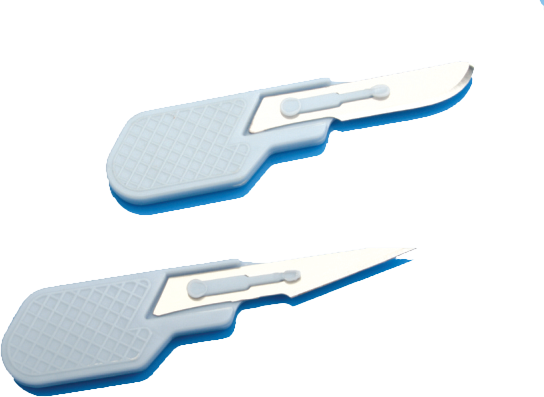
Disposable Mini Surgical Scalpel (Stainless Steel Blades)
In an operating room setting, the right surgical tools, including everything from instruments to surgical lighting, can be just as critical as the moxie and ways of your surgical brigades. Having the right surgical scalpel blades for the specific procedures can make a huge difference in the surgical platoon’s success and ensures the stylish possible outgrowth for cases. This is particularly true for minimally invasive surgery, as well as ophthalmic, cardiovascular and endoscopic procedures. The perfection of the surgical cutter blades plays a critical part in any successful surgery.
Item No.: NMS1006
Size: 10#, 10A, 11#, 15#, 15C.
Blister pack, different color plastic handle available.
Item No.: NMS0906
Size: 10#, 10A, 11#, 15#, 15C.
Blister pack, different color plastic handle available.
1. Swann-Morton No. 3 Scalpel
2. Becton Dickinson #11 Scalpel
3. Cardinal Health #15 Scalpel
4. Medtronic #17 Scalpel
5. Boston Scientific #19 Scalpel
6. Johnson & Johnson Vision Care #23 Scalpel
7. Cooper Surgical #25 Scalpel
8. Steris #29 Scalpel
9. VWR International #31 Scalpel
10. Zenith Healthcare #33 Scalpel
There are a few things to consider when choosing whether or not to use a disposable mini surgical scalpel. Here are some pros and cons to help you make your decision:
PROS:
-They're easy to use -Disposable mini surgical scalpels are less likely to cause infection than reusable scalpels
-They're more comfortable for the patient
- they offer greater precision
CONS:
-The blades are very sharp, so there is a risk of cutting yourself if you're not careful
-Disposable mini surgical scalpels can be more expensive than reusable scalpels
-You'll need to dispose of the scalpel properly after use
There are a few reasons that vets might use disposable mini surgical scalpels. The first reason is that they are small and maneuverable, which is helpful when dealing with smaller animals. Additionally, disposable scalpels eliminate the need to sterilize instruments between uses, which can save time in the operating room. Finally, because they are disposable, there is no risk of cross-contamination between patients.
A surgical scalpel is a small, sharp blade that is used to make incisions in the skin during surgery. A non-surgical scalpel is a small, sharp blade that is used to make incisions in the skin for other purposes, such as biopsies.